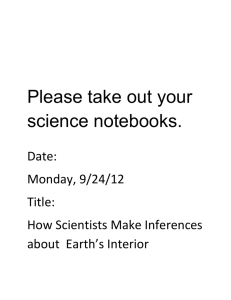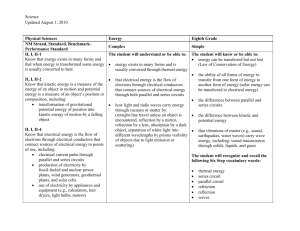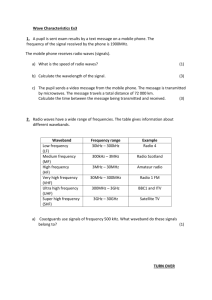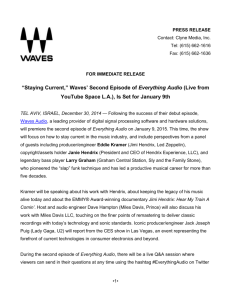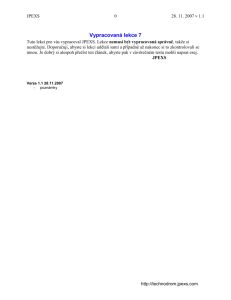Daily Quizzes
advertisement
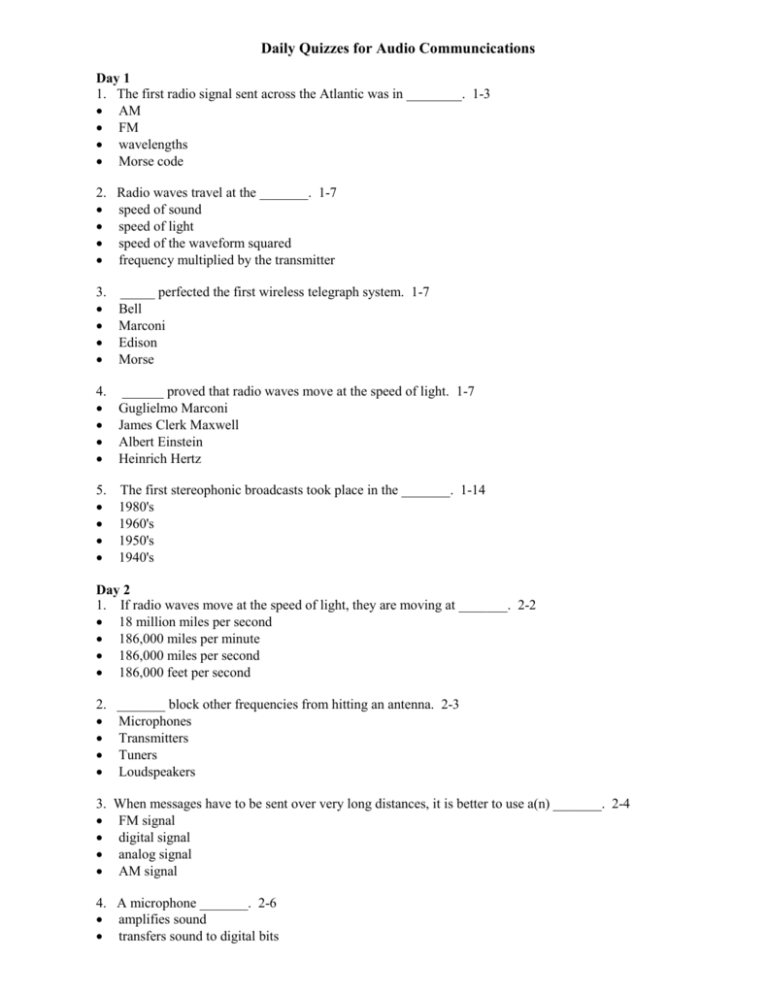
Daily Quizzes for Audio Communcications Day 1 1. The first radio signal sent across the Atlantic was in ________. 1-3 AM FM wavelengths Morse code 2. Radio waves travel at the _______. 1-7 speed of sound speed of light speed of the waveform squared frequency multiplied by the transmitter 3. _____ perfected the first wireless telegraph system. 1-7 Bell Marconi Edison Morse 4. ______ proved that radio waves move at the speed of light. 1-7 Guglielmo Marconi James Clerk Maxwell Albert Einstein Heinrich Hertz 5. The first stereophonic broadcasts took place in the _______. 1-14 1980's 1960's 1950's 1940's Day 2 1. If radio waves move at the speed of light, they are moving at _______. 2-2 18 million miles per second 186,000 miles per minute 186,000 miles per second 186,000 feet per second 2. _______ block other frequencies from hitting an antenna. 2-3 Microphones Transmitters Tuners Loudspeakers 3. When messages have to be sent over very long distances, it is better to use a(n) _______. 2-4 FM signal digital signal analog signal AM signal 4. A microphone _______. 2-6 amplifies sound transfers sound to digital bits turns sound waves into electrical signals removes static noise 5. A tape recorder is _______. 2-6 an input device an output device both an input device and an output device None of these answers Day 3 1. Radio signals with low frequencies have ___________. 3-3 long wavelengths poor reception strong reception fewer interruptions 2. In order for each radio station to be heard clearly, it must have _________. 3-4 its own call letters its own frequency its own FCC license its own wire service 3. The government agency that oversees radio and other forms of broadcasting is the _______. 3-5 National Communications Forum Federal Broadcasting Consortium Federal Communication Commission National Communications Committee 4. To broadcast using public airways, a radio station must _______. 3-6 have sponsors be registered with the local government be approved by the ICC have a license 5. A transmitter changes sound waves so that they carry a coding called __________. 3-8 modulation radar amplitude microwaves Day 4 1. A radio station's plan for broadcasting is called a _______. 4-2 format structure sales forecast file master 2. The person who decides on the various features of a broadcast is the __________. 4-3 disc jockey general manager sponsor program director 3. A wire service provides radio stations with ________. 4-10 news updates wiring transmitters sponsors 4. Segments of radio broadcasts were often pre-recorded and stored on a _______. 4-9 format cart transmitter mixer 5. Carts were frequently used in radio stations to _______. 4-9 store audio equipment store commercials or news segments so they are cued and ready help engineers find music selections organize the broadcasting order Day 5 1. _______ is radio that has no commercials and does not require you to pay a fee to get it. 5-2 Muzak Digital music Public radio Private radio 2. KDKA was _______. 1-9 the first commercial broadcasting radio station a famous rock-and-roll station in America in the 1950's the first radio station west of the Mississippi the first country music radio station 3. The technical name for sound is __________. 1-9 sonar waveform audio wavelength 4. Radio waves are part of the ________ spectrum. 1-10,1-17 ultraviolet gamma ray electromagnetic microwave 5. The Golden Age of radio was from ________. 1-12 1960 - 1970 1900 - 1910 1925 - 1950 1950 - 1960 6. Radio waves carry sound and are also used in ______. 1-18 traffic radar and gamma rays laser pulses and television signals television and traffic radar television and sonar 7. A(n) ____ signal sends sounds over radio waves the same way your voice sends what you are saying across the room. 1-18 wave FM digital analog 8. A ______ signal converts sound waves into a series of numbers. 1-18 digital analog wave frequency 9. A CD is an example of a(n) _____. 2-6 digital recording analog recording wire service AM transmitter 10. A(n) ______ is a piece of audio equipment that makes electrical signals more powerful. 2-6 speaker amplifier microphone recording head 11. Speakers _______. 2-6 remove static noise convert electrical signals from an amplifier into sounds store sound in a digital form can record and erase sound 12. When you are preparing to read on the air, you should_______. 2-11 review the text you are going to read and underline words to be stressed relax your body focus on what you are going to say and why all of these answers 13. You can tell a radio station's general location by ________. 3-12 listening to the accent of the announcer the owner's address the power of its transmitter the station's call letters 14. ______ is the changing of the height of sound waves by a transmitter. 3-8 frequency modulation (FM) carrier waves amplitude modulation (AM) microwave relaying 15. A paid advertisement on a radio station is called a ______. 3-12 spot format paid minute public service announcement 16. A ____handles advertising. 5-1 sales manager station engineer formatter programmer 17. Ham radio is a type of _______. 3-14 training program for radio professionals semiprofessional radio amateur radio radio funded by contributions from listeners 18. FM stands for “_______.” 3-8 Frequency Modulation Frequency Mixer Frequent Manipulation Fiber optic Modulation Day 6 1. Narrowcasting is _______. 6-3 targeting people with a specific taste in music playing more commercials developing a set format and never changing it public radio 2. The broadcast ______ chosen for a station gives it its unique sound. 6-4 spot format wiring volume 3. It is important to choose a ______ which compliments the format. 6-4 format volume vocal style formatter Day 7 1. Unsuitable material that is broadcast on the air should be found in the _______. 7-3 format listing spot log program log radio activity list 2. Radio station personnel maintain program logs so that ____. 7-3 the logs can be reviewed by owners the on air personalities can be paid correctly the right news and sports stories are read the logs can be reviewed by the FCC for suitable material 3. Three seconds without any broadcast sound is considered ______. 7-4 peaceful dead air zero time downtime 4. The _____ requires stations to keep a program log. 7-3 FCF CFC CCF FCC Day 8 1. When preparing a broadcast, it is important to ________. 8-2 speak carefully and clearly not talk while a song is playing announce your station's call letters frequently All of these answers 2. The ______ meter tells you if you are speaking too loudly. 8-2 UU VU UV TV Day 9 1. A podcast is . 9-1 a special website a music video satellite radio a recorded audio or video broadcast 2. Satellite radio . 9-3 uses satellites in space requires a special radio receiver to unscramble the data displays the song title, artist and genre all of these answers 3. Which is not a benefit of listening to an internet radio site? 9-2 music is on-demand music is customized to your personal taste records your favorite morning show less commercials 4. Podcasts can be downloaded ________. 9-1 only once on a computer or mobile device only on weekends after paying a monthly subscription fee 5. Listeners of ________ pay a subscription fee for access to broadcasted programs. 9-3 satellite radio podcasts streaming radio webcasts Day 10 1. Sound is measured in _______. 10-1 decibels frequencies rays None of these answers



